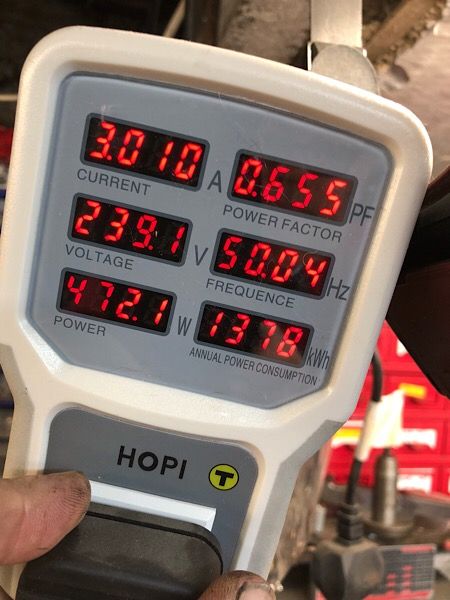Posted by not done it yet on 20/07/2017 23:58:23:
Yes of course, but your pressure washer has a single phase motor.
Precisely what difference does that make? 3HP (2240W) is being derived from the single phase mains, whether or not the motor is single phase or three. Just need a few more Watts to run the VFD for the 3 phase motor.
3kW is 3kW single or thee phase.
Is that all there is to it though?
Apologies for reviving this thread back from the dead, but I have been looking into this topic – curiously wondering why I need 22 amps for a 2.2kw (3hp motor).
As i understand it, a single phase input to a VFD will require 1.73x the output (sq. root of 3).
I have a WEG 2.2kw VFD which can be run on either 3 phase or single phase 230v input. (model CFW300B10P0B2DB20)
It's paired to a 2.2kw 230v motor.
The VFD states that it will output 10a 230v, (2.2ish kW), and to do that, will require 12a 230v 3 phase, or 22A, 230V single phase input.
So we have some VFD efficiency losses, but crucially, the single phase to 3 phase conversion increases the current draw by 1.732x
A Hitachi document (**LINK**  states:
states:
[quote]
As background, for a given power (kW/hp) and voltage, the ratio of current for a singlephase circuit will be 3 (1.732) times that of a three-phase circuit.
This means that the input rectifier will see 1.732 times the current of the output devices. When powered by three-phase, these currents are nearly the same.
This higher current would destroy the input of the drive if an oversized inverter were not used.
Furthermore, full-wave rectified single-phase power has a much higher harmonic content than full-wave rectified threephase power. This would introduce large ripple into the DC bus of the inverter, potentially causing other malfunctions.
Larger size inverters have larger bus capacitors, thus more inherent filtering.
So upsizing the drive ameliorates the ripple problem as well. The rule of thumb Hitachi recommends is to start with the 3-phase motor’s nameplate full load amperage (FLA) rating and double it.
Then select an inverter with this doubled continuous current rating.
This will give adequate margin in the input rectifier bridge and bus capacitors to provide reliable performance.
NOTE: Fusing or Circuit Breakers should be sized to match the INVERTER input current rating, NOT the motor current rating! As shown in the figure below, single-phase power should be connected to the L1 (R) and L3 (T) terminals, and optionally, a jumper should be placed between terminals L2(S) and L3(T). This jumper prevents the inverter from detecting a loss-of-phase should that function be active. Otherwise, the L2 (S) terminal should remain unconnected.
Beyond the inverter considerations, be sure to size components upstream of the inverter to match the INVERTER’S current ratings, NOT the motor’s. This would include, but not be limited to wiring, fusing, circuit breakers, contactors, etc.
[/quote]
Now, it's entirely possible that the Huan Yang / eBay VFDs are actually stating their input current rather than output, which might mean you're running those 3hp motors at something like 1.75hp max.
The WEG VFD I have chosen is a sensorless vector control one, and they state that it should closely match the power rating of the motor for the sensorless feedback stuff to work.
I'm still trying to get a clear understanding of it all.
SillyOldDuffer.







